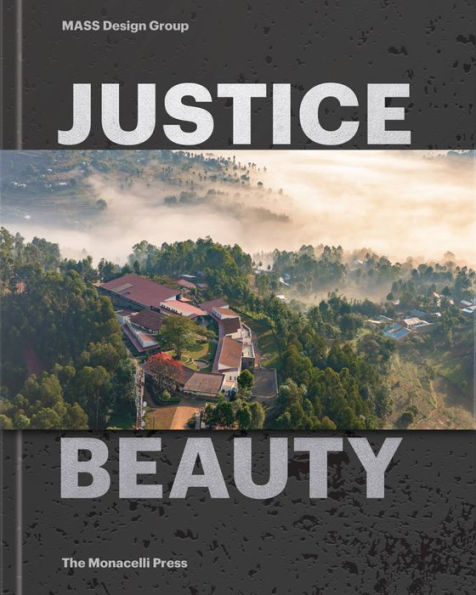
Justice Is Beauty: MASS Design Group
384
Justice Is Beauty: MASS Design Group
384Hardcover
-
SHIP THIS ITEMTemporarily Out of Stock Online
-
PICK UP IN STORECheck Availability at Nearby Stores
Available within 2 business hours
Related collections and offers
Overview
Founded in 2008, MASS Design Group collaborated with Partners In Health and the Rwanda Ministry of Health to design and build the Butaro District Hospital in Rwanda, a masterwork of architecture that also uniquely serves a community in need. Since then, MASS has grown into a dynamic collaborative of architects, planners, engineers, filmmakers, researchers, and public health professionals working in more than a dozen countries in the fields of design, research, policy, education, and strategic planning.
Amid ongoing recognition (the 2018 American Academy of Arts and Letters Award in Architecture, the 2017 Cooper Hewitt National Design Award in Architecture), MASS's most recent project, the National Memorial for Peace and Justice in Montgomery, Alabama, has been featured in more than 400 publications, including the New York Times, the New Yorker, and the Washington Post. Mark Lamster of Dallas Morning News called the memorial "the single greatest work of American architecture of the twenty-first century."
Justice Is Beauty highlights MASS's first decade of designing, researching, and advocating for an architecture of justice and human dignity. With more than thirty projects built or under construction and some 200,000 people served, MASS has pioneered an immersive approach in the practice of architecture that provides the infrastructure, buildings, and physical systems necessary for growth, dignity, and well-being, while always engaging local communities with attention to the specifics of cultural context and social needs.

Product Details
| ISBN-13: | 9781580935272 |
|---|---|
| Publisher: | The Monacelli Press |
| Publication date: | 12/17/2019 |
| Pages: | 384 |
| Product dimensions: | 8.30(w) x 10.20(h) x 1.40(d) |
About the Author
Alan Ricks is a founding principal and the chief design officer of MASS Design Group. He leads strategy and design of the firm, which has projects in over a dozen countries that range from design to research to policy—a portfolio that continues to expand the role of design in advancing a more just world. He is the William B. and Charlotte Shepherd Davenport Visiting Professor at the Yale School of Architecture. He regularly speaks, writes, and creates films focused on the role of architecture in catalyzing social change.
Chelsea Clinton is a global health advocate and New York Times bestselling author. Through her writing, teaching, and role as vice chair of the Clinton Foundation, she works tirelessly toward a healthier, safer, and more equitable world.
Read an Excerpt
“Hopelessness is the enemy of justice,” Bryan Stevenson had stated before and repeated again, standing in the stepped amphitheater of the Memorial for Peace and Justice. In April 2018, fifty thousand people came to inaugurate the work of the Equal Justice Initiative’s new memorial to victims of racial terror, and they crowded in the first morning for a dedication and prayer.
Bryan spoke spatially. The memorial sits on Montgomery’s second-highest hill, he said, where we can see the towers, the statehouse dome, the steeples, the architecture of power across Montgomery. But now, this memorial was orienting us physically, and spiritually, onto higher ground.
He presented another false dichotomy to revise. “The opposite of poverty is not wealth,” Bryan would say. “The opposite of poverty is justice.” To contrast poverty against wealth is to ignore the structural conditions that reinforce that poverty: conditions like poor housing, poor healthcare, poor food, “poor” architecture.
Bryan Stevenson and Dr. Paul Farmer and Dr. Agnes Binagwaho had already identified the false binaries in their fields; in building their architecture, we encountered ours. We might say that the opposite of beauty is not ugliness, it is injustice. Beauty is not a choice if we fight for truth, it is the central artery that delivers it. Beauty IS Justice.
This book tells the story of how we arrived at this philosophy. It is a collection of projects, conversations, and reflections from our team at MASS Design Group, as well as our partners and friends and mentors, during our first ten years in practice. At the core is a group of people wrestling with the existential crisis we found ourselves in—and trying to mine purpose from the contradictions that the false dichotomy has laid in front of us.
The false dichotomy is not just a mindset problem; it is indicative of all the ways human rights in our society have been commodified and removed from the public domain. It has created an unequal distribution of services and power, reserving both for those who can afford them. Architecture, like healthcare and law, is always of the public’s province—and when commodified, is always threatened by a false dichotomy that undermines its value.
The public has been extracted from architecture. Sold off and outmaneuvered, some feel the architect is no longer necessary. But in working on these projects, our understanding of the essential value of architecture has only been fortified. Our work presented here is not to offer a solution to our existential reflection, but instead to reveal how a few of us have wrestled with that reality. To build, with hope.
We began confronted with the the idea that we had a difficult choice between Justice OR Beauty, and came to commit to the hope and belief that we could have both,
Justice AND Beauty. But in the end, we have learned that the search for Beauty is the search for Justice.
Justice IS Beauty.
—Michael Murphy, from the Introduction.
